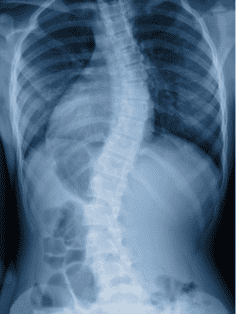As a young girl, I dreamed of becoming a professional ballerina. I studied ballet rigorously; however at a young age I was diagnosed with scoliosis, a curvature of the spine. After a lot of ups and downs, including wearing a back brace for two years in high school, there was no other option besides spinal fusion surgery to correct my scoliosis. Three surgeries later, I was told that my dancing career would not be possible. Luckily, I had a high school Physics/Calculus teacher who recognized how upset I was and encouraged me to pursue engineering. After figuring out that this wasn’t all about conducting trains, and that my skills in math and science could be put to all sorts of uses, I became excited about the possibility of becoming an engineer. My disrupted dreams of dancing professionally fueled my passion to dedicate my career to finding ways to help those with scoliosis and other spinal disorders.
“My disrupted dreams of dancing professionally fueled my passion to dedicate my career to finding ways to help those with scoliosis and other spinal disorders.”

I attended college at Virginia Tech and double majored in Engineering Science & Mechanics and Mathematics. I was extremely lucky to have my first job out of college be at a spinal medical device company who really cared about the patients we treat. I started my career at K2M, a smaller medical device company based in Leesburg, VA. I began as an entry level engineer in research and development, designing innovative spinal medical devices.
As I progressed in the R&D department, I also went to Georgetown University and received my M.S. in Biomedical Technology Development & Management. After learning more about business with my master’s degree, I wanted to expand my management skills which led me to a role where I managed a team of quality engineers and specialists. After gaining more management experience and learning more about the operations side of the business, I missed surgeon/customer interactions and decided to move back to the R&D group where I managed a team of engineers responsible for upfront pipeline development and new technology for the business.
In late 2018, K2M was acquired by Stryker, a Fortune 500 medical device company, and I was offered a new role in their Advanced Operations department which utilizes both my quality and R&D background. Currently, I serve as Director, Advanced Operations for Stryker Spine with a global team of engineers and specialists.

I feel lucky to be where I am today, and would love to see more young women pursue engineering, but I think it’s tough to get there sometimes without the help or guidance of mentors.
I believe that a large part of not having enough women in STEM careers is due to a lack of representation. In addition to girls being told that STEM careers are “not for girls”, it’s still not common for young girls to see themselves in these careers as often they don’t have real life examples to look up to. I believe movies and television are getting slightly better at showing women in STEM roles (e.g. Katherine Johnson, Mary Jackson, and Dorothy Vaughan in Hidden Figures; Shuri in Black Panther; Felicity Smoak in Arrow; Temperance Brennan in Bones; Dana Scully in The X Files—to name a few of my favorites). But if we really want to see progress, young girls need to see both fictional and real life examples to fully believe that they can succeed in these fields.
I also believe strongly that diversity increases our ability to innovate and come up with new ideas, so in order to get more diversity into the pipeline and our industries, we need to all work together to inspire the next generation.
“If we really want to see progress, young girls need to see both fictional and real life examples to fully believe that they can succeed in [STEM] fields.”
I recently volunteered to speak to young girls in a Boolean Girl webinar. I shared my story of going from a scoliosis patient to an engineer who designed the components that surgeons use to treat my condition. I even had some of the devices I helped work on implanted into my back during my last back surgery in 2008! My hope is that my story and journey inspires them to think about engineering as a possible career for them, even when that may not be what they want today. But if things change, I want them to know that you can rise to any challenge you face.
I also spoke a bit about the process of designing medical devices, what software we use, how engineers receive patents and intellectual property, and how when working with medical devices quality must be core to everything that you do. My current job in Advanced Operations focuses on how our medical devices are made and I likened it to “The Exact Instructions Challenge” on Youtube. In the video, the kids write down instructions of how to make a peanut butter & jelly sandwich and then the Dad follows those instructions exactly and ends up with a bunch of crazy sandwiches (one of my favorites being the one where he just puts the whole jar of jelly in between two slices of bread). It’s pretty funny, but it’s actually very relevant because without clear instructions and a repeatable process, things can get pretty messy! I think making a comparison between the high-tech job I do, and something as simple as making a PB&J makes something that may seem very technical from the outside, more approachable and understandable. Having concepts boiled down and relatable to something the students already know makes them more comfortable with the subject and also more able to picture themselves in your role one day.
“Having concepts boiled down and relatable to something the students already know makes them more comfortable with the subject.”
My experience with Boolean Girl was fantastic! One thing that really stuck out to me was during the Q&A session, when a young girl asking if I was treated differently because I was a girl. I often get this question at the high school level, but I was surprised that such a young participant asked this question. I don’t want them to be worried about being treated differently so early on and I certainly don’t want that to be the thing that stops them from pursuing a career in STEM. However, unfortunately sometimes I have been treated differently because I’m a woman, so it was a tough question to answer. The key to me though is self confidence; believing in yourself is critical to success. If you love math and science and you are passionate to use these things to change the world, no one can stop you!
Even though I was a little nervous leading up to the event, after the event I was over the moon with inspiration and joy of interacting with all of these bright young women – it was honestly the highlight of my month!
“The key is self confidence; believing in yourself is critical to success.”
Outreach to girls in particular is extremely important to ensure women continue to fill the STEM pipeline. The needle honestly hasn’t moved as much as I’d like in the last decade as far as women who graduate college with STEM degrees. I truly believe that diversity is the key to best-in-class innovation and changing the world for the better. We can’t realize this without more women in the pipeline and making it to careers in STEM. For me this starts from the earliest ages, ensuring that young girls can picture themselves in these roles.
It is imperative that we stop the narrative of these are “not careers for girls” and that we foster a culture of empowerment from an early age. By increasing diverse representation within the educational system, I believe we can substantially increase the amount of women in the STEM pipeline. And if they feel supported, part of a community, and a sense of belonging throughout their education, I believe they will stay with it through college and beyond. STEM outreach at all levels and ages is important to foster that community and sense of belonging. With these changes to the pipeline, I believe we can significantly increase the diversity in STEM industries and consequently bring about greater innovation to the world.
“If [girls] feel supported, part of a community, and a sense of belonging throughout their education, I believe they will stay with [STEM] through college and beyond. “
Related content:
- “Boolean Girl” Is on a Mission: Teach Girls to Code and Build Electronics
- “Boolean Girl” Is Full STEM Ahead With Online Webinar
- SWE Member Gretchen Hein on Why She Mentors
- Digital Exclusive: Calling All Girls to STEM
- Podcast: Dr. Kerri Phillips Encourages Girls to “Stay in the Game”
Author
-

Catherine Stone is Director of Advanced Operations at Stryker Spine, where she designs innovative spinal medical devices. She first joined SWE in 2002 as an undergraduate at Virginia Tech.






